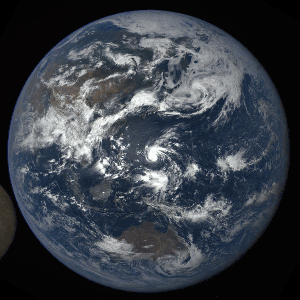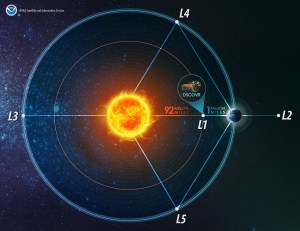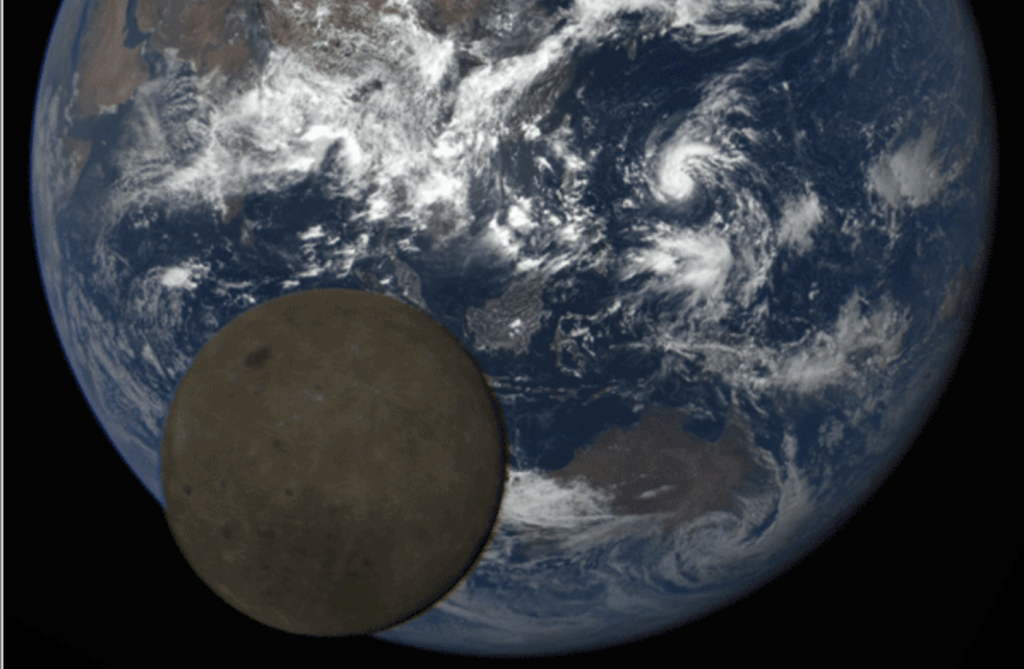A NASA camera on board the Deep Space Climate Observatory (DSCOVR) satellite captured a rare lunar transit across the face of a sunlit Earth. The images, which feature a fully lit far side of the moon, were captured between July 4 at 11:50 pm ET and July 5 at 3:18 am ET.

This was actually the second time a lunar photobomb was photographed by DSCOVR; the first occurred about a year ago, on July 16, 2015.

Located one million miles away, DSCOVR acts like a solar storm buoy out in space. The satellite’s primary mission is to provide real-time solar wind monitoring, which allows the National Oceanic and Atmospheric Administration (NOAA) to provide early warnings for potentially dangerous space weather events.
To accomplish its mission, DSCOVR was placed in a unique location called the sun-Earth Lagrange point 1, or L1.
L1 is a spot between the Earth and the sun where Earth’s gravity pull is equal and opposite to the gravity pull from the sun. DSCOVR stays within the L1 orbit as our planet moves around the sun, essentially hovering between the sun and an illuminated Earth at all times.

At this location, the moon can be seen crossing the face of the Earth from DSCOVR’s perspective only once or twice a year.
NASA’s Earth Polychromatic Imaging Camera (EPIC), a four-megapixel CCD camera and telescope, captured the images. Back in March, the same camera captured a unique view of a solar eclipse. During the eclipse, people on Earth looked up and saw the sun eclipsed by the moon. At the same time, a lunar shadow was seen moving across the face of the Earth from the perspective of EPIC.

Located on one side of DSCOVR, EPIC points toward the Earth at all times, providing scientific data on the ozone, vegetation, cloud height and aerosols in the atmosphere. On the other side of the satellite is another instrument that points toward the sun, providing measurements of solar particles.

“DSCOVR will be our eyes on the sun, and give us early warning when it detects a surge of energy that could trigger a geomagnetic storm destined for Earth.” — Dr. Stephen Volz, assistant administrator for NOAA’s Satellite and Information Service.
Keeping a watchful eye on solar weather is important to keep astronauts and technology safe from highly energetic particles that spew out from our sun. While these particles have the potential to generate beautiful, harmless events known as auroras, they can also cause serious damage to technology, including important national assets, and be harmful to people living in space.
Brilliant lights of an aurora south of Australia spotted by @Astro_Jeff on @Space_Station: https://t.co/uacbv0lXkz pic.twitter.com/W81VxLNE1Z
— NASA (@NASA) July 10, 2016
Such storms inflame Earth’s ionosphere, disrupting various high-frequency communications used in the commercial aviation industry. Other particularly powerful solar events known as coronal mass ejections can send waves of magnetic plasma that can damage satellites and disrupt electrical power grids if they were to come our way.
With DSCOVR, scientists can better understand how solar activity affects the environment in and around the Earth. Similar to terrestrial storm warnings here on the ground, NOAA uses DSCOVR to keep a watchful eye on the sun and inform the government and commercial satellite owners if a solar storm is coming their way.































Comment